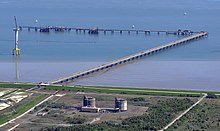
Brunsbüttel is a town in the district of Dithmarschen, in Schleswig-Holstein, northern Germany that lies at the mouth of the Elbe river, near the North Sea. It is the location of the western entrance to the Kiel Canal.

A floating production storage and offloading (FPSO) unit is a floating vessel used by the offshore oil and gas industry for the production and processing of hydrocarbons, and for the storage of oil. An FPSO vessel is designed to receive hydrocarbons produced by itself or from nearby platforms or subsea template, process them, and store oil until it can be offloaded onto a tanker or, less frequently, transported through a pipeline. FPSOs are preferred in frontier offshore regions as they are easy to install, and do not require a local pipeline infrastructure to export oil. FPSOs can be a conversion of an oil tanker or can be a vessel built specially for the application. A vessel used only to store oil is referred to as a floating storage and offloading (FSO) vessel.

Petronet LNG Limited is an Indian oil and gas company formed by the Government of India to import liquefied natural gas (LNG) and set up LNG terminals in the country. It is a joint venture company promoted by the Gas Authority of India Limited (GAIL), Oil and Natural Gas Corporation Limited (ONGC), Indian Oil Corporation Limited (IOC) and Bharat Petroleum Corporation Limited (BPCL). Petronet LNG Limited, one of the companies in the Indian energy sector, has set up the country's first LNG receiving and regasification terminal in Dahej, Gujarat, and another terminal in Kochi, Kerala. While the Dahej terminal has a nominal capacity of 17.5 million tonnes per year, the Kochi terminal has a capacity of 5 million tonnes per year. Plans to build a third LNG terminal in Gangavaram, Andhra Pradesh were dropped in October 2019.
LNG Hrvatska d.o.o. is a company that operates a floating liquefied natural gas (LNG) regasification terminal in Omišalj on the island of Krk, Croatia. It commenced operations on 1 January 2021, with full capacity booked for the next three years.
Golar Spirit is a floating storage and regasification unit (FSRU). It is the world's first FSRU converted from a liquefied natural gas (LNG) carrier.

Qatar Gas Transport Company Limited, commonly known as Nakilat is a Qatari shipping and maritime company. Its LNG shipping fleet is one of the largest in the world, comprising 74 vessels. The company also jointly owns one Floating Storage Regasification Unit (FSRU) and 4 very large LPG carriers (VLGCs). Through its in-house ship management, Nakilat manages and operates the four very large LPG carriers and 14 LNG carriers.
KN Energies (KN) is an oil and LNG terminals operator based in Klaipėda, Lithuania. The company was founded in 1994. The company operates the Klaipėda Oil Terminal, Subačius oil terminal, Klaipėda LNG terminal, Açu LNG terminal (Brazil) and Klaipėda small-scale LNG reloading station.

The Świnoujście LNG terminal is a liquefied natural gas (LNG) import terminal at Świnoujście, in the extreme north-west of Poland near the Polish-German border. The LNG terminal is operated by Polskie LNG S.A., a subsidiary of Gaz-System. The cornerstone for construction was laid on 23 March 2011 and it took its first LNG delivery on 11 December 2015. The terminal's regasification capacity is 5 billion cubic metres per annum. The terminal is currently being expanded and once the expansion is complete in 2023, it will have a capacity of 7.5 billion cubic metres per annum and be able to satisfy about half of Poland's annual natural gas demand. Together with the 10 bcm of natural gas that Poland will receive annually from Norway via the Baltic Pipe natural gas pipeline, the Świnoujście LNG terminal will allow Poland to achieve its long-term goal of becoming fully independent of Russian natural gas, which had previously been the source of almost all of the country's natural gas.

Regasification is a process of converting liquefied natural gas (LNG) at −162 °C temperature back to natural gas at atmospheric temperature. LNG gasification plants can be located on land as well as on floating barges, i.e. a Floating Storage and Regasification Unit (FSRU). Floating barge mounted plants have the advantage that they can be towed to new offshore locations for better usage in response to changes in the business environment. In a conventional regasification plant, LNG is heated by sea water to convert it to natural gas / methane gas.

A liquefied natural gas terminal is a facility for managing the import and/or export of liquefied natural gas (LNG). It comprises equipment for loading and unloading of LNG cargo to/from ocean-going tankers, for transfer across the site, liquefaction, re-gasification, processing, storage, pumping, compression, and metering of LNG. LNG as a liquid is the most efficient way to transport natural gas over long distances, usually by sea.

Klaipėda LNG terminal is an liquefied natural gas import terminal in the port of Klaipėda, Lithuania. It cost US$128 million to construct. The developer and owner of the project is KN Energies.

FSRU Independence, delivered in March 2014 is a LNG carrier designed as a floating LNG storage and regasification unit (FSRU) chartered by KN to be used as a LNG import terminal in Lithuania. The vessel can store 170,000 m3 (6,000,000 cu ft) of natural gas and can supply all of Lithuania's need for natural gas. The vessel started operating in the autumn of 2014. It provides some diversification of Lithuanian gas imports away from Russia.
MT GDF Suez Neptune is a liquefied natural gas (LNG) carrier, which has been used as a floating storage and regasification unit (FSRU) for LNG at the Aliaga Etki LNG terminal in Aliağa district of İzmir Province, western Turkey between 2016 and 2019.
Botaş Dörtyol LNG Storage Facility is a floating storage and regasification unit (FSRU) for liquefied natural gas (LNG) in Hatay Province, southern Turkey. It is the country's second floating LNG storage facility after the Egegaz Aliağa LNG Storage Facility.
MT MOL FSRU Challenger is a Bahamas-flagged liquefied natural gas (LNG) carrier, which is currently laid up in Singapore.
The Höegh Esperanza is a Floating Storage and Regasification Unit (FSRU) ship owned by Höegh LNG Holdings. From the end of 2022 the FSRU will be used in the Wilhelmshaven LNG terminal.
Botaş Saros FSRU Terminal is a liquefied natural gas (LNG) terminal in Turkey. Owned by the Turkish state-owned corporation BOTAŞ, it is located at the northeastern shore of the Gulf of Saros in Turkey. It will be used for converting LNG imported by LNG carriers back to natural gas using a floating storage regasification unit (FSRU), and transferring the natural gas into the national pipeline network system. Projected in 2019, the construction works started in November 2020, and it is expected to be completed early 2023. All legal efforts to stop the project due to environmental concerns failed.
The Lubmin LNG terminals are two liquefied natural gas (LNG) terminals in Lubmin, Mecklenburg-Vorpommern, Germany, on the Baltic Sea. Both shipping terminals were rushed into operation following the 2022 Russian invasion of Ukraine and the global natural gas supply crisis and the loss of Russian pipeline gas, which had long provided over fifty percent of German gas energy demand.

Inkoo LNG terminal is a liquefied natural gas (LNG) shipping terminal, situated near Ingå, Finland on the Gulf of Finland. It became operational in January 2023, and received first gas in April 2023, with some shipments for Estonia. The floating regasification equipment and port facility was built to offload marine-shipped LNG to Finland following the cutoff of Russian pipeline gas in the aftermath of the 2022 Russian invasion of Ukraine, and will have the capability over time to supply gas to the Baltic countries as well.









